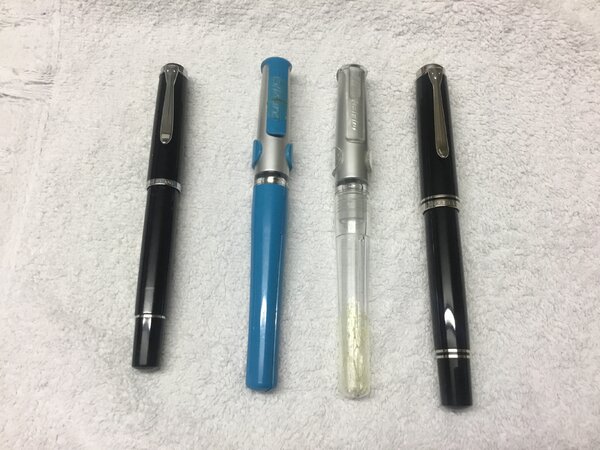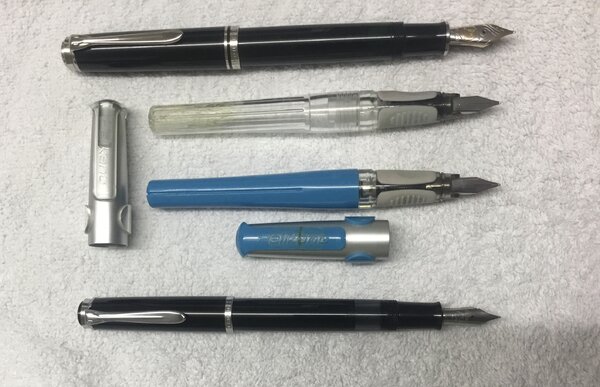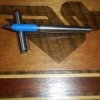Search the Community
Showing results for tags 'pelikano'.
-
From the album: Mercian’s pens
L-R: ’Classic’ M205 ‘F’; P480 Pelikano ‘F’; P480 Pelikano ‘F’; Souverän M805 ‘F’. If you look closely you will see that I have broken the clip on my blue Pelikano, and the barrel on my transparent Pelikano. They are not as robust as Lamy Safaris.
- 0 B
- x
-
From the album: Mercian’s pens
Top-bottom: Souverän M805 ‘F’ with bi-colour nib; P480 Pelikano ‘F’; P480 Pelikano ‘F’; ’Classic’ M205 ‘F’. If you look closely, you will see that I have broken the clip on the blue Pelikano, and the barrel on the transparent one. They are not as robust as Lamy Safaris.
- 0 B
- x
-
Dear lovers of Pelikano pens, When I started school in Germany in the 1970s, the use of a fountain pen was mandatory and at my school the teachers strongly recommended the use of a Pelikano with an A nib (A being for Anfänger= beginner). This started my obsession with fountain pens and to this day, my primary interest is in student fountain pens. That said, I am not so enamoured with the current Pelikano line and when it comes to modern student pens, I prefer the Lamy Safari range. This may be anathema to hard-core Pelikan fans, but that’s how I see it. Picture 1 shows my collection from the first model 1 through to model 7S plus a modern Pelikano for comparison: In my view, there was little improvement after model 2 was released in 1965. The feed in model 1 pens is problematic. Both the blue and black versions came into my collection blocked and the pens needed literally months of soaking before they started to work. No other pen that I’ve ever bought (and I’ve bought a few) needed that kind of treatment. I started school with a model 4 and later had a model 5. The Pelikano 5 Super with the metal barrel is my favourite, albeit that it was a flop for Pelikan. Picture 2 shows the box that I made to house my Pelikan collection. The stylised pelican is cut from Queensland Walnut (the name is a misnomer- Queensland Walnut not a walnut tree at all) and has been inlaid into Queensland maple. Picture 3 shows the box with the top layer of pen trays removed. The bottom left tray has no Pelikano pens at all. Instead there is a loose collection of other pens, including two special edition GeHa pens. GeHa was ultimately bought by Pelikan, so I suppose the Geha pens are not that out of place. To the right of the photo are my two Pelikan Pura fountain pens. Picture 4 shows the storage for the original pen boxes underneath the two layers of trays. I like keeping the original boxes, but I like to have my pens in trays. I realise that the Pelikano line of student pens is not everyone’s cup of tea. After all, the nibs are nails and the pens are made to a budget. However, to me the Pelikano line is what fountain pens are all about. The Pelikano pens are robust and write well. I don’t have any problem writing with a ‘nail’. I'd love to hear from other Pelikano fans. Ollie
- 15 replies
-
- pelikano
- custom pen box
-
(and 1 more)
Tagged with:
-
When it comes to fountain pen collecting, my primary interest is where it all started for me, that is German student fountain pens from the 1970s. I thought it timely to undertake a review of the key pens of the era and to discuss their differences. For this review, I have focussed on seven pens from my collection, which all date from the mid-1970s, the time that I started primary school in Germany. In the photo above, you can see from left to right: Standard blue Pelikano Model 4. This was released in 1973, although it looks largely the same as the Pelikano 3 that it replaced. Whilst the Pelikano pens were available in red, blue, green, yellow and black, most German shops only carried blue and red pens. Blue was by far the most common colour.Pelikano Model 4 in black: This was released a little later than the blue version and, as far as I am aware, was not sold in great numbers in Germany. I bought this one as NOS from the USA.Pelikano Model 4 Antimacchia: This is an export only model, destined for those nations (e.g. Italy) where kids did not like the metal cap and wanted to see a bit more colour.GeHa: This particular pen is a special edition Jeans model. This special edition gets a different clip as well as a barrel in a jeans-patterned barrel, complete with painted on contrast stitching. GeHa, having less market penetration than Pelikan, pushed the innovation angle. The two key innovations are a reserve tank built into the feed and a cleverly different cartridge. Whilst one can use a GeHa cartridge in a Pelikan (and in any other pen designed to take international cartridges), international cartridges will not fit in a mod-1970s GeHa pen (that all changed, once the GeHa was bought by Pelikan).An ERO office pen: Whilst Pelikan and GeHa had the bulk of the student market, there were many companies producing pens with similar styling. One of these is this ERO office pen.Montblanc Carrera: Up until Montblanc decided sometime in the 1980s that it wanted to be a pure luxury product maker, it produced several lines of pens designed to appeal to older students. The Carrera is the most of common of these.Pelikano Happy Pen: These were an attempt by Pelikan to appeal to older students and to offer some differentiation from the standard Pelikano that was seen as beginner’s pen. I suspect that Pelikan styled this pen to look more like the Montblanc Carrera. Colours aside, it is identical to the Pelikano Model 4. All of the pens above are cartridge fillers. All take two cartridges, albeit the GeHa pen only takes proprietary cartridges and the Montblanc Carrera was also available as a piston filler for the export market. All pens come with steel nibs. In the case of the Carrera, a gold plated nib was available. Student pens are designed to be inexpensive and robust, hence the sturdy steel nib. In the photo below, I compare the standard Pelikano 4 with the GeHa model to highlight the innovations in the Geha. The little orange tab that can be seen at the end of the GeHA fed is for the reserve tank. If you run out of ink and the spare cartridge in the pen has already been used, you can use the clip of the pen to push the orange tab into the feed, thus releasing enough ink to write a number of pages. The orange tab can be reset after use. Whilst I question the utility of the feature, after all the pen already has a reserve cartridge in the barrel, it does make for a nice marketing gimmick. Where the product development people got really clever is to devise a special cartridge that has a thinner end that will only fit GeHa pens and a standard end to fit all pens that use international cartridges. I take my hat off to the person that came up with that one, long before other firms embraced the idea of creating a monopoly for replacement cartridges. GeHa went one better out the door by creating a proprietary cartridge that would also fit other pens. I learned on this forum that a Lamy cartridge can be used (in reverse) in a GeHa pen and I can confirm that it works (you can see used Lamy cartridge in the photo). The photo below shows the Montblanc Carrera. I always wanted one of these as a child, but that had more to do with the clever marketing than it did with the pen’s features. Being roughly twice as expensive as the equivalent Pelikano, I did not acquire one as a child. Now I have several of these. What makes the Montblanc Carrera different to all the others is that it can be easily disassembled for repair. That is a huge advantage for older pens, given that ABS plastic made in the 1970s is starting to go brittle. I have posted an article in Repair Q&A section, where I have put this feature to use, to repair a broken feed. All the other pens in this review are nigh on impossible to disassemble and repair. The other feature that makes the Montblanc Carrera different is that it does not rely on friction alone to secure the cap. The section has small raised metal tabs that secure the cap with a distinct click. To me this is the better solution, as the friction system starts to fail after a couple of years’ use. I have also included an example of the tyre stand that was used to effectively to market the pen, creating a racing car linkage. This stand will also fit Pelikano pens of the era. Most of these pens come with different widths and types of nibs, including the obligatory A (for Anfänger= beginner) for primary school children. The steel nibs are as tough as nails and will keep on working, after a pen has been dropped or employed as a weapon to poke the kid sitting next to the writer (not that I would have done such a thing- at least not that I will admit to it). I will allow myself the observation that when it comes to collecting fountain pens. In my opinion, too much emphasis is placed on the flexibility of gold bibs. If you write with a soft touch, as one is supposed to do, it makes little difference if the nib is a hard steel or a flexible gold nib. All of the pens in this review have been used as daily writers by me and none of them have let me down. So which one is my favourite of all of the mid-1970s pens in this review? For me, the Montblanc Carrera wins hands down. It is just a little better made than the others, has a superior mechanism for securing the cap and can be disassembled for repair. As a child I fell in love with the marketing of the Montblanc Carrera- now I am in love with its features. At no point have I coveted it for the brand, but the allure of the luxury brand is probably the reason that second-hand examples are so much more expensive than any of the others.
- 14 replies
-
Hi Need help in finding a place or help fixing my Pelican Pelikano P460 fountain pen. Yes it's a student model, but I love the way it writes. the plastic of the body snapped in half. I don't have a clue why. so the tip(the nib part) is stuck in the cap. can someone help? i don't as of now have that old a receipt or I would try pelican. maybe I will try anyway. thanks.
-
- pelican pelikano
- pelikano
-
(and 3 more)
Tagged with:
-
I recently stumbled upon a classified listing for NOS stationery items, among those, there are some Pelikan Pelikano P10 fountain pens and some Pelikan Twist P20 ballpoint/ fountain pen sets. According to the seller these products were manufactured sometime in the late 80s or early 90s and all have their original boxes, cartridges and documentation. I really don't have much of an experience with Pelikan pens, so I would like to know if both of these pens are good buys or if I should look somewhere else? They are going for about $20 and I plan to use them as everyday writers. Thanks for your advice!
-
Back when I was in grade 8, I used to own a Pelikano. Unfortunately I was quite naive back then and one by one lost quite a few fountain pens or lost them to class thieves, but of all my memories the P450 was to me the best of the best. I still remember to this day that when my Pelikano got stolen I was in tears and although they were not the first tears for a lost fountain pen, they were the most significant ones. Although it was just 3-5$ back in the day I assume it will be much more expensive if I come across any anymore. I have been off these forums for ages, so am really not up to the mark but would love it if anyone could point me to anyone who still sells them i.e the Pelikano P450 2000-2003 year model. I would even be willing to give sacrifice a Black Pilot Metropolitan (with box very sparingly used bought from UAE) or be willing to PIF it on your behalf if anyone would want to part with one or two of their Pelikano P450's in exchange. Looking forward to your help friends
-
A short time back I saw on Instagram that Pelikan was releasing a new version of its Pelikano school pen to be called Pelikano UP. I haven't found it on the company website yet but UP most likely intends to imply upgrade, which this new version seems to be, at least to me. Available in two finishes, champagne and anthracite, I found it on offer on eBay from Seitz so I ordered the anthracite for my Pelikano flock. The pen came so quickly I haven't had time to make room for it in the box! For those of you who don't collect the school pen line, here is a photo showing a rough history of the Pelikano series. And to show the progression of the nibs and grips This new version features a wide metal clip and a nice anthracite colored barrel which makes to my eye the most attractive Pelikano in years, losing the plastic look of the past couple versions. It does keep the triangle grip section, and while I don't mind Lamy's triangle grip, the Pelikano grip is much shorter and I don't find it as comfortable to my hand. But I prefer M600 and M800 size pens so take that with a grain of salt, these grips will be just fine in a youngster's hand. I'll leave it to others to speculate about the change to the triangular grip section, but this new model continues the triangular grip but it is slightly larger and a bit more comfortable than last year's model. The section does have one other change however. This new model pen has the Pelikano name on the barrel rather than the cap and the section has a key slot cutout that ensures the name on the barrel always lines up with the nib. Kind of fun to play with trying to trick it. So, how does it write? I took mine out of the box, removed the section and gave it a quick flush with a bulb and warm water, then plugged in the blue cartridge it came with. A little moist paper towel wrap on the nib to get the flow going and it was off to the races. This pen came with a Medium nib and it is smooth and forgiving as you would hope a school pen to be. It's a great little writer right out of the box and I like it. As soon as my grandsons get to writing, they're going to get one of these from their grandpa.
- 14 replies















